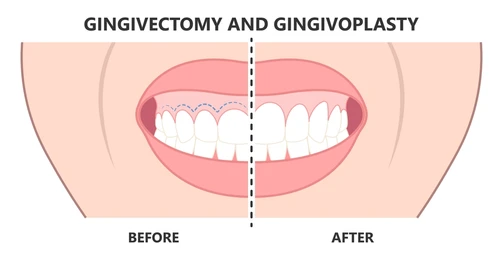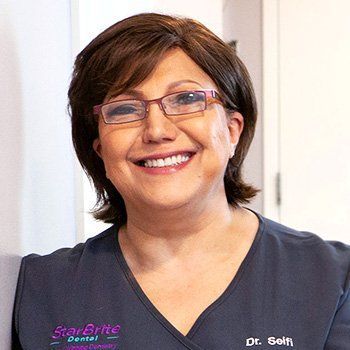The Pros and Cons of Gingivectomy vs Gingivoplasty—Which To Choose?

Should you receive a gingivectomy or gingivoplasty? These two procedures have different purposes and are recommended for different dental and oral situations. Your StarBrite Dental expert will make the proper recommendation to improve your oral health or give you the smile you really want.
Based on a careful examination of your oral health, imaging and an understanding of your medical history, you will receive the best recommendation that can keep your smile shining for your whole life.
What Is the Difference Between a Gingivectomy and Gingivoplasty?
On the surface, these two procedures are similar so it may be a little difficult to tell them apart. It can help to look at the difference in the endings of the words.
-ectomy:
refers to surgical
removal of a specified part of the body, as in appendectomy or tonsillectomy.
-plasty:
refers to
molding or formation of a body part, such as rhinoplasty (plastic surgery on the nose) or angioplasty (unblocking a coronary artery).
The other part of this word,
gingiva, is the medical term for the gums around your teeth.
The most important difference between gingivectomy versus gingivoplasty has to do with the purpose of each procedure. The actions taken to achieve these purposes are actually fairly similar.
One Purpose of a Gingivectomy
One of the main purposes of a gingivectomy is to remove hypertrophic gum tissue.
Hypertrophic refers to excessive growth of part of the body, in this case, the gums. It is not uncommon for some people to grow excessive gum tissue that then covers part of their teeth.
This condition can occur during orthodontic treatment that utilizes metal braces because of the difficulty keeping the teeth adequately clean. It also occurs as a result of taking certain medications such as calcium channel blockers. Pregnancy can also cause this overgrowth of gingiva.
The overgrowth of gum tissue will cover part of the teeth. Red, swollen papillae (the gum tissue between the teeth) can be unsightly. The patient will generally be unhappy with the appearance of their smile. This overgrowth of gum tissue will harbor the growth of bacteria on the surface of the teeth which is another reason it should be promptly removed.
To
restore the original gingival contour, precision surgery will be used to remove the excess gum tissue.
Another Purpose of a Gingivectomy: Treating Periodontal Disease
Periodontal disease is an advanced form of gum disease. While
mild gum disease is called
gingivitis,
advanced gum disease is called
periodontitis
or
periodontal disease.
When this advanced stage is reached,
deep pockets have formed around the teeth. The gums are supposed to adhere tightly to the teeth, but when the gums are puffy, infected and unhealthy, they
will pull away from the teeth.
Once these deep periodontal pockets exist, bacteria will thrive and can quickly create tooth decay and infections that spread beyond the gum pockets. Tooth and
bone loss can follow. To restore proper, natural pockets, the first step is often
scaling and root planing of the teeth roots. That’s because the least invasive treatment is usually the best place to start.
Scaling involves cleaning away the calculus (tartar) on the surface of the teeth that is located under the gum. At the same time, the root’s surface will be smoothed, referred to as
root planing, to eliminate any uneven areas where bacterial infection can get started. After scaling and root planing, the gums are given time for healing. Your dentist will help you pick the best course of treatment.
The Next Step in Treating Periodontal Disease
If there is not a significant improvement in the gum pockets after scaling and root planing, then a gingivectomy may be recommended to step up the treatment of these gum pockets. A gingivectomy can be performed on a single tooth or multiple teeth.
In addition to removing excessive gum tissue, a gingivectomy is used to remove diseased gum tissue.
Inflammation in these small pockets results in deeper, more severe pockets that can rapidly destroy the supporting structures of the teeth. These pockets must be reduced. If the scaling and root planing did not completely heal the tissue, then a gingivectomy may provide more effective treatment of periodontal disease.
During a gingivectomy, your skilled dentist will remove diseased tissue with surgical reshaping, resulting in an improved and more natural shape to the gums. As the diseased gum tissue is removed, the remainder of the gingiva will heal tightly to the teeth again and take on a normal shape. What will remain will be healthy, natural-looking gums.
This periodontal surgery can save a person’s smile by generating
healthy gum tissue around the teeth once again. With healthy gum tissues all around, there should be no further infection and there should be no further damage.
Gingivoplasties and Their Unique Purpose
Yes, there is a difference when looking at a gingivectomy compared to a gingivoplasty. A gingivoplasty is done for cosmetic reasons to reshape gum tissue. In these cases, this is healthy tissue, not
diseased tissue that’s undergoing gum contouring. This could also be referred to as
gingival sculpting
or
gingival contouring surgery.
One of our dentists may recommend a gingivoplasty as a way of improving your smile. Alternatively, some of our patients will request this procedure if they are unhappy with their appearance.
For example, they may note that their gums have an unusual shape or may have irregular gingival margins. Their gum line could cover so much of their teeth that it looks like they have abnormally short teeth.
Actually, their teeth probably have normal shapes—they are simply covered by too much otherwise healthy gum tissue. Some people call this a
gummy smile. To eliminate this gummy smile, this is one of the cosmetic procedures we can do. To perform a gingivoplasty, this type of excessive gum tissue is trimmed away so it heals into a normal shape with the teeth appearing normally long.
How Gingivectomy and Gingivoplasty Surgeries Are Done
How is gingivectomy performed? And how is a gingivoplasty performed? The techniques are quite similar.
Before your periodontal surgery, you will receive a consultation to ensure that you understand your surgery, any risk, and the expected result. If this treatment is being done to treat periodontal disease, there will be an explanation of exactly why this treatment is needed. You will also be educated on how to prevent a recurrence of the problem that now requires surgery to correct it.
Both procedures start with administering a local anesthetic to completely numb the area to receive treatment. Your dentist will make a careful evaluation and measurement of your gum tissue to determine how much gum tissue should be removed, either for aesthetics or for treatment of gum disease. Then your dentist will begin to remove excess tissue with a scalpel or laser. We often use lasers for this procedure because there is less bleeding and faster healing. However, scalpel procedures may be necessary for more extensive tissue removal.
For the gingivectomy, any diseased gum tissue will be surgically removed and the remaining healthy gum will be reshaped so it can heal into a normal appearance. The result will be the removal of unhealthy, infected pockets of gum tissue and the restoration of healthy adhesion of gum tissue to the teeth. With regular brushing, flossing and professional care, future gum disease is much easier to prevent.
Frequently Asked Questions About a Gingivectomy and Gingivoplasty
We want every patient at StarBrite Dental to understand their treatments and be able to get answers for any questions they have. Below, you’ll find some of the more frequently asked questions we hear from our patients.
- What are the indications for a gingivectomy?
There are a few indications for a gingivectomy. The most common goal of a gingivectomy is reduced gum disease. Removed pocket depth is part of the way we treat gum disease, with problems such as pockets between the teeth, with the goal of preventing tooth loss. All in all, a normal and healthy gum line is vital to protect you from infection and other gum related issues.
Also, excessive gum growth due to medical reasons may cause a doctor to refer a patient to a dentist for this procedure.
A gingivectomy may be the treatment of choice to correct cleft gums. - What are the indications for a gingivoplasty?
This is usually a cosmetic procedure so that reduced gum tissue will expose more of a normal-shaped smile. Sometimes lifting the gum line is all that is needed to make a smile more beautiful. It can also be used to correct gum craters that could become problematic if left untreated. - What are the costs of each procedure?
The cost of a gingivectomy or gingivoplasty will vary by how many teeth will be treated. If you would like to get an estimate of the cost for your own treatment, please call our office and ask to schedule a consultation with one of our experienced dentists. - What is the expected recovery time for each procedure?
Your progress will be examined approximately one week after your procedure. By this time, your gums should be less sore. Complete healing may take several weeks. If at any time you are concerned about bleeding from the surgical site or post-op pain, please contact us right away. - What are the benefits of each procedure?
We will offer a gingivectomy and gingivoplasty to those patients who need these procedures to eliminate deep pockets of infection or to give them a more normal gum line and smile. After healing, a person who receives a gingivectomy should see their gums heal tightly to their teeth, with an aesthetic shape to the gums. A person who receives a gingivoplasty can see a more normal and beautiful smile. A gingivoplasty can also prepare a patient to receive a crown or veneer on a tooth that may have a little too much gum tissue to permit the crown or veneer to be placed. There needs to be a certain length of tooth available to grip a crown or veneer and a gingivoplasty will reveal that length which can enable the crown or veneer to be placed. - What should you do after a gingivoplasty or gingivectomy?
After your procedure is done, you will receive exact instructions from one of our dentists on how to care for the areas that have received surgery. You will need to eat only soft foods while your gums heal. An antibacterial mouthwash may be prescribed for you so you can rinse the affected areas. You will be instructed on when and how to brush or floss the affected areas prior to your dentist examining your post-surgical results. You should not use an oral irrigator until healing has progressed well.
If there is any bleeding after a period of time, you should contact our office right away so we can help you. We will also give you instructions on how to alleviate any pain you might experience after your surgery. You will be scheduled for a followup appointment so we can ensure that your healing is progressing well and that you are getting the result you want.
StarBrite Dental Is Here to Support Your Oral Health
Our
skilled and empathetic dentists and staff will do everything they can to support and improve your oral health. Whether you simply need plaque removed during a regular cleaning, or you need periodontal surgery to correct advanced gum disease, we are ready to keep you comfortable and relaxed during your care.
Please consult with us and let us know what help you need. If you have been told you need a gingivectomy or gingivoplasty, we will schedule you for this care as soon as possible. You can reach our Rockville, Maryland, office at
(301) 770-1070.


